-
PDF
- Split View
-
Views
-
Cite
Cite
Mary Brennan, Catherine McDougall, Jo Walsh, Yanick J. Crow, Joyce Davidson, 013. COPA syndrome - a new condition to consider when features of polyarthritis and interstitial lung disease are present, Rheumatology, Volume 56, Issue suppl_6, October 2017, kex356.059, https://doi.org/10.1093/rheumatology/kex356.059
Close - Share Icon Share
Background: In 2015, Watkin et al. (Nat Genet 2015;47:654-60) described mutations in COPA to cause an autosomal dominant lung and joint phenotype demonstrating variable expression and sometimes non-penetrance. The COPA gene encodes a subunit of the coatomer protein complex, required for retrograde protein trafficking from the golgi apparatus to the endoplasmic reticulum. How dysfunction of COPA leads to inflammatory disease is unknown.
Aims: We present a case report to illustrate this new disorder, which should be considered in a child with features of polyarthritis and interstitial lung disease.
Methods: Retrospective case review.
Results: A 4-year old girl presented to Paediatric Rheumatology with an 18 month history of joint pain. There was extensive joint swelling and she was ANA positive. She was diagnosed with polyarticular juvenile idiopathic arthritis and commenced on steroids and methotrexate, resulting in clinical remission 13 months later. Aged 6 years, due to persistent cough, decreased exercise tolerance and finger clubbing, she underwent a respiratory workup. Widespread reticulo-nodular changes were seen on chest X-ray; lung function showed a restrictive defect (FEV1 and FVC both 54% predicted); CT chest demonstrated interstitial lung disease; numerous lipid-laden macrophages, but no pathogen, were seen on bronchoalveolar lavage; CFTR genetic analysis revealed the genotype F508del/R117H (7T) (sweat chlorides 52 and 38mmol/l). FEV1 improved to 64% following antibiotic treatment. A subsequent pH study showed significant gastro-oesophageal reflux and anti-reflux medications were added. Methotrexate was stopped. A scheduled lung biopsy was postponed when she became unwell with macrophage activation syndrome. She was treated for a lupus like condition with steroids and cyclophosphamide. Subsequent lung biopsy revealed a mixed picture of inflammation and aspiration. She underwent fundoplication and treatment with Rituximab. Currently, aged 10 years, lung function remains stable (FEV1 74%, FVC 79% predicted). Current medications include mycophenolate mofetil, hydroxychloroquine, prednisolone and prophylactic antibiotics. Given the combined joint and lung disease, we undertook genetic analysis and identified a mutation in COPA (c.727G>A/p.Asp243Asn in exon 9). The aspartate at 243 is conserved to yeast. The p.Asp243Asn substitution is not listed on the publically available SNP databases, and is predicted as highly damaging. Importantly, Watkin et al. described a substitution to a different amino acid at this same position (p. Asp243Gly). The 4 mutations published in COPA syndrome all fall within the WD40 repeat domain of the protein.
Conclusions: To our knowledge this is the first UK case of COPA syndrome to be described. This rare condition should be considered in a child with features of polyarthritis and interstitial lung disease. The relevance of the CFTR sequence variants is unclear.




Comments